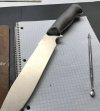Nathan the Machinist
KnifeMaker / Machinist / Evil Genius
Moderator
Knifemaker / Craftsman / Service Provider
- Joined
- Feb 13, 2007
- Messages
- 15,668
this is a good example of what I'm talking about when I say that it doesn't always get the best heat treat. As much as I like CRK, their heat treat is pretty soft. Nowhere near optimized for a folding knife, in my opinion.


